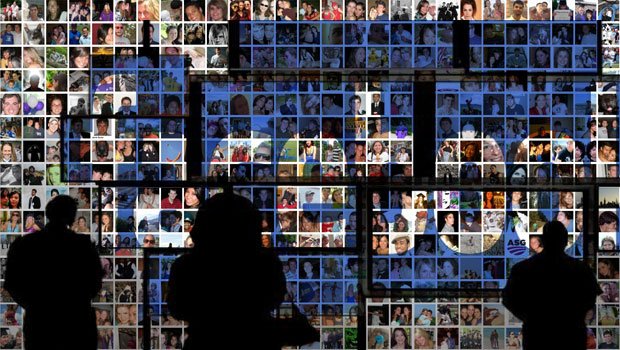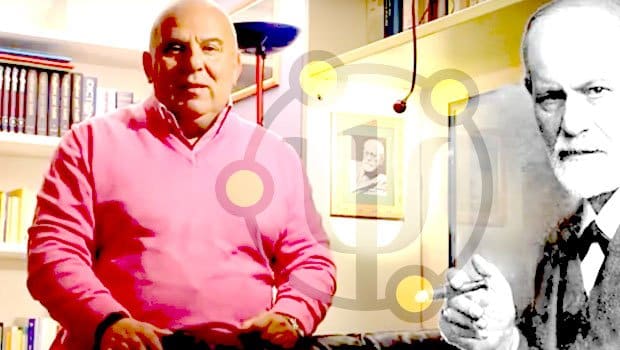In this article I would like to collect some of the reflections that I’ve been making during these last months after getting to know and registering myself on Facebook. For the few people that still don’t know, Facebook (at the beginning known with the name Thefacebook) is a free-access social networking website that is operated and privately owned by Facebook Inc. which has 200 million users. 1
It is similar to a virtual square where groups of friends meet each other and can exchange, as happens in real meetings, opinions, information and moods.

In effect my personal feedback is that the virtual communication exposes the protagonists to a transference saturated, more than others, of idealization. The transference 3 as everybody knows is the unconscious acting out again, more or less camouflaged, of previous action-reaction schemes, connected to primal traumatic experiences, which have determined an energetic accumulation that acts as the motor, which processes the putting into act of the transference repetitions.
The transference appears spontaneously in all human relationships, exactly as in the relation between patient and doctor: it acts much more energetically especially when it is least suspected. The psychoanalysis doesn’t create the transference, it simply reveals it to the consciousness and uses it to guide the psychic processes towards the desired aim. In normal human relationships (between Lovers, between Master and disciple, trainer and athlete, priest and religious assembly, office manager and his staff, etc.) it manifests itself in a reciprocal unconscious state, altering the relationships on the basis of anachronistic conditionings.
The transference drive is evident in the communication within Facebook: if we observe attentively the initial interactions, above all between “new” friends, a familiarity is evident from the very beginning which would never be possible in a real interaction: the two protagonists without knowing it, utilizing certain perceptive aspects, even subliminal, a photo, a lexical way of expressing themselves, a place of residence, a profession, etc. project, in a massive way, precedent fragments of experience on to the other person.
The interesting thing is that often such emotional pills bounce between several members of the group, infiltrating the dialogues reciprocally. One of the most frequent things, for example, is the drifting towards the playing on words (nicely described as “cazzeggio” [a slang term, which contains a phallic expression], there where an aim of libido masturbation can be found), which passes as a powerfully contagious virus from one protagonist to another, making it difficult, at times, to remain on a serious level of interaction.
It must be said that Facebook is a virtual square; therefore, it is not specifically delegated to scientific discussions or to philosophical or political debates (for this necessity there are specialist forums, as for example the one in this Journal, progressively less used since the “just to say” has been prohibited).
The absence of the interlocutor’s face, of the emotional sound of the voice, the crucial motor expressivity and gestures that are of fundamental support to the complexity of the interpersonal communication, often determines those chaotic infiltrations of contained and emotional states so well described by the Prof. Callieri on the pages of this magazine:
“From what has been said, the risk of the closing in the imaginal reality appears very delineable (once, regarding this fact, perhaps we would have spoken of “rich autism” – see: A. Ballerini), drawing from new forms of co-existence (e.g. the sociability of Liliana Deroche-Gourcel); and here the alarm of the Turkle is justified, “the headshrinker of the cyberspace” who maintains (in: Life on the Screen, 1966) that the concept of the Ego will be considered less and less as an unitary instance and more and more as a result of a variety of fragments and projections (The Protean Self, by Lifton, 1993), that reflect and reproduce the world-environment, the Um-Welt; this protean self, as a multiple and decentralized or poly-centric identity, is not necessarily to be interpreted as a sign of hysteria or schizophrenia”. 4
It is evident how this kind of “virtual bar,” as I love to define it, but without any discrediting intention in this definition (the most important encounters of one’s life, also the scientific ones, are often made at the table!) is inclined to the protection of the pleasure principle. If there is someone in the interaction group that knocks our susceptibility we can ignore him totally (it is an unwritten rule but practically de facto), or with time, eliminate him from our interaction with a simple click! of the mouse (I challenge any of you to resist the temptation of “cancelling” a tedious presence in society, if the same simple possibility were granted to you).
The transferral interaction on Facebook is inclined to the idealization since it lacks a series of perceptive factors that in the real life concur to the definition of the judgment of the other person: aesthetic aspect, odour, the pleasure or less of the voice sound, the respect of the animal territory, etc. All tend to show the best of oneself: it is difficult to find written: “look, I’m mean, look I’m violent, look I’m presumptuous, etc.”, even if a careful eye doesn’t have great difficulty in perceiving such features of the character. The reason why the overwhelming majority of users register on Facebook is in an attempt, more or less aware, of mitigating their own loneliness.
The convulsive life of our times, fragmented by the inhumanity of our cities, by the irrational organization of work, has left less and less space to the pleasant and rewarding human interaction, that until a few generations ago, was carried out in the public squares of Italy (and of the world) and in the bars: a drive activity in the last analysis, sexual and aggressive, in its infinite ramifications.
Among other things, it is probable that the abolition of this sexual-aggressive dilution of the human drive also has a negative economy in the progressive and unstoppable reduction of the duration of marriages: the partner becomes more and more the “trigger zone” of the sexual-aggressive discharge.
Therefore, in general, the fundamental impulsion, as I define love in my article “If This is Love”, is an impulsion sustained by the sexual drive (it is obvious on the other hand, that the virtual interaction, as any other interaction, also lends itself to the paranoid personalities who are searching for persecutory objects upon which to bind their own aggressiveness).
In these attempts of sexual-aggressive binding (the friendship on the other hand, according to the fulminating definition of Freud, is a love inhibited in the goal) one of the characteristics of Facebook, regarding the real interaction, is that of a greater disinhibition in the emotional manifestations.
This, in my opinion, is due to the absence of the interlocutor’s gaze, where the eye, the pupil of the other person, is the privileged place of projection of the super-ego activity, not by chance, almost always described in analysis as a stare that observes us.
On Facebook we show ourselves but, paradoxically, nobody watches us!
The role of the gaze appears most evident in the difficulties that the compulsive subjects in analysis have, for example, to maintain the classic position on the analytic bed: the absence of the perception of the other person (the analyst is in a defilated position) makes the control of the compulsive ideas (often of aggressive content) even more difficult.
Sometimes, in the serious cases (borderline or psychotics), face-to-face transitory phases must be allowed otherwise the session becomes so anxiety-inducing to provoke the breach of the therapeutic alliance.
Returning to the idealizing quality of the relation on Facebook it is obvious that the eventual frustration will produce a still greater disappointment, as is always verified when a highly idealized object falls, in comparison to the reality, from the pedestal where we had unconsciously placed it. As Prof. Callieri acutely reminds us: ”… Of course the risk is… that the virtual reality can lead us away from the real one, sometimes generating alarming symptoms of omnipotence, with a lack of control of judgement, that reverberate in an every day reality, with obvious maladjustment. Above all, these eventualities authorize us to ask ourselves if, in an eventual well defined and specific psychopathology of the Internet circle, it is possible to alternate between a concrete world and a virtual one without risking dramatic psychopathogenic conflicts.” 5
In an interesting sociological study published online by the British magazine The Economist, 6 the Sociologist Cameron Marlow disclosed the data regarding the socialization of the registered users on Facebook. According to the internal data on the social networking website the average number of friends per user is 120. But even when the user reaches a list of 500 friends a considerable disparity between this number and the effective socialization exists: a man sends comments to 17 friends and he chats and exchanges e-mails with 10 of them; a woman is on average a little more sociable and sends comments to 26 friends and chats or exchanges e-mails with 16 contacts on Facebook. I regard this auto limitation of the interaction as an unconscious tendency in the search of consenting friends (approval) in a pressure to protect the pleasure principle. Such flattery of the narcissism unavoidably strengthens the addiction with a psychic mechanism completely analogous to that of the other forms of addiction.

Written by: Quirino Zangrilli © Copyright
Translated by Linda De Nardo
Key words
Facebook
Transference
Idealization
Summary
The social interaction on Facebook is characterized by highly idealized phenomenons of transference. The absence of other sensorial channels facilitates the condition for users to give ground to narcissism.
Note:
1 Facebook. (12 aprile 2009). Wikipedia, L’enciclopedia libera. Tratto il 15 aprile 2009, 14:14. ![]()
2 Bruna Marzi, Manifestazioni attuali del tabù del toccare: chat, sms, mms, blog, etc., “Scienza e Psicoanalisi”, 3 maggio 2006, ![]()
3 Il Transfert, voce dell’Atlante di “Scienza e Psicoanalisi” . ![]()
4 Bruno Callieri, La dimensione narratologica nell’attuale cultura del virtuale, “Scienza e Psicoanalisi”, 3 novembre 2002. ![]()
5 Bruno Callieri, op. cit. ![]()
6 “Science & Technology: Primates on Facebook“, Economist.com, 26/02/2009
Nel 2024 riceve il Premio Accademico d’Onore della Accademia Culturale Internazionale Cartagine 2.0.
Nel 2024 docente ad Almaty – Kazakhstan presso il workshop di psicoanalisi sul tema della violenza, promosso dall’Università di psicoanalisi di Mosca in collaborazione con l’Istituto svizzero di micropsicoanalisi.
Doctor Quirino Zangrilli was born in Fiuggi in 1955. Graduated with honours in Medicine and Surgery in 1980, he practices Psychoanalysis, with intensive method, since 1982. He is author of 72 scientific pubblications. He has attended as speaker or president of session to many national and international scientific Conventions. His book “La vita:involucro vuoto” (Life: empty involucre), published by Borla in 1993, has been in use by the Chair of Dynamic Psychology at Turin’s University since 1994. He is the author and founder of the multimedia review “Psicoanalisi e Scienza” (Psychoanalysis and Science), the most read Italian on line review of psychoanalysis. In 2012 he participated as a Speaker at the Scientific Festival of BergamoScienza. In 2013 he illustrated his research on the maternal-fetal interaction in the Special Session of the XI World Congress of Perinatal Medicine in Moscow with his relation “Intrauterine Imprinting”. He is visiting teacher at Moscow Institute of psychoanalysis and training psychoanalist of Swiss Institute of Micropsychoanalysis.
In 2024 he is a teacher in Almaty – Kazakhstan at the psychoanalysis workshop on the topic of violence, promoted by the Moscow University of Psychoanalysis in collaboration with the Swiss Institute of Micropsychoanalysis.
In 2024 he received the Honorary Academic Award of the Carthage 2.0 International Cultural Academy
Le Le Docteur Quirino Zangrilli est né à Fiuggi en 1955. Diplômé avec mention en Médecine et Chirurgie en 1980, il pratique la psychanalyse depuis 1982, en utilisant une technique intensive. Il est l’auteur de 72 livres et publications scientifiques. Il a participé en tant que conférencier ou président de session à de nombreuses conférences scientifiques nationales et internationales. Son livre “La vie : enveloppe vide”, publié par Borla en 1993, est adopté depuis 1994 par la Chaire de Psychologie Dynamique de l’Université de Turin. En 1994, il a reçu le “Prix national Ciociaria de médecine”. Il a conçu et fondé le magazine multimédia “Psicoanalisi e Scienza”, qui est le magazine de psychanalyse en ligne en italien le plus suivi au monde. (Source : Entireweb, Alexa, Google, Virgilio, Arianna., etc.). En 2012, il a participé en tant que conférencier à la colloque scientifique de BergamoScienza. En 2013, il a exposé ses études sur l’interaction materno-fœtale lors de la session spéciale du XIe Congrès mondial de médecine périnatale à Moscou avec le rapport “Intrauterine Imprinting”. Il est chargé d’enseignement au cours de spécialisation de trois ans en psychanalyse, psychothérapie psychanalytique et consultation psychanalytique à l’Université de Moscou. Il est membre didacticien de l’Institut Suisse de Micropsychanalyse et de la Commission pour la Pratique de celui-ci.
En 2024, il enseigne à Almaty – Kazakhstan à l’atelier de psychanalyse sur le thème de la violence, promu par l’Université de Psychanalyse de Moscou en collaboration avec l’Institut Suisse de Micropsychanalyse.
En 2024, il reçoit le Prix Académique Honoraire de l’Académie Culturelle Internationale Carthage 2.0.
В 2024 году является преподавателем в Алматы – Казахстан на семинаре по психоанализу на тему насилия, проводимом Московским университетом психоанализа в сотрудничестве со Швейцарским институтом микропсихоанализа.
В 2024 был награжден Почетной академической премией Академии Международной Культуры «Карфаген 2.0».












